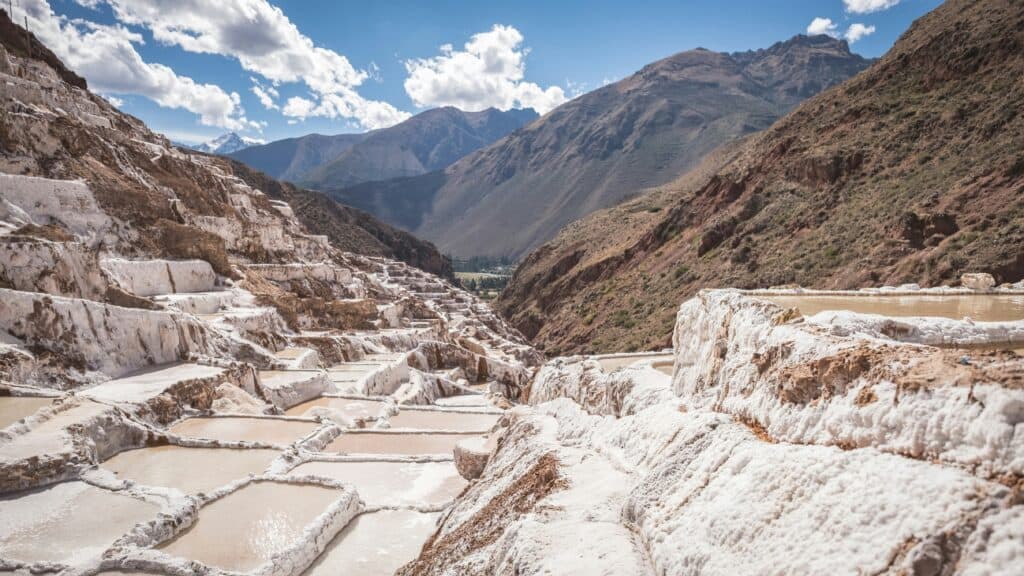How is Lithium Extracted and Why it Matters

Lithium plays a vital role in powering clean energy technologies, spanning from electric vehicles (EVs) to large-scale batteries employed in electricity storage at power facilities. Latest forecasts see a demand surge of over fivefold by 2030, primarily driven by the increasing use of advanced gadgets such as EVs and smartphones. Lithium-ion batteries drive these devices, delivering extended lifespan and rapid recharging capabilities while retaining a lightweight design.
The global appetite for lithium is projected to skyrocket by 500% by 2050, attributed to the widespread adoption of these cutting-edge technologies. Lithium stands as a pivotal element within the clean energy supply chain, ensuring a dependable and diversified lithium supply ranking among the top priorities for the U.S. Department of Energy (DOE).
However, this heightened demand has sparked concerns regarding the environmental impact of lithium mining and extraction processes. In response to these challenges, there’s been an attempt to pivot towards sustainable lithium extraction techniques aimed at minimizing ecological damage and fostering responsible resource stewardship.
What is Lithium?
Lithium is a highly reactive alkali metal renowned for its exceptional heat and electrical conductivity properties. These attributes render it indispensable in various industries, including glass manufacturing, high-temperature lubricants, chemical synthesis, pharmaceuticals, and the production of lithium-ion batteries, widely used in electric vehicles and consumer electronics.
How is Lithium Extracted and Processed?
Presently, there exist two primary methods for the extraction of lithium. The predominant method for obtaining lithium today involves extracting it from liquid brine reservoirs located beneath salt flats, known as traditional lithium brine extraction.
The extraction process involves pumping these brines to the surface and allowing them to evaporate in designated ponds, resulting in the concentration of lithium and other accompanying elements.
The process of recovering lithium from brine is typically straightforward yet time-consuming, spanning from several months to a few years. These ponds allow the brine to undergo solar evaporation over several months or years until much of the liquid water content is depleted. Alongside lithium, the brines typically contain potassium and sodium. Facilities often manage multiple large evaporation lithium brine ponds at various stages of evaporation, with some ponds utilized for extracting other metals, such as potassium, while awaiting optimal lithium concentration. In certain cases, reverse osmosis (RO) may be employed to expedite the brine concentration process.

Upon achieving the desired lithium concentration in an evaporation pond, the brine is transferred to a lithium recovery facility for extraction. Once the extraction process is finalized, the remaining brine solution is reintroduced into the underground reservoir.
These cost-effective operations are well-suited for regions with abundant lithium brines and arid climates, such as South America’s ‘lithium triangle.’
Impact of Lithium Extraction on Water Resources
The extraction of lithium from brine sources can exacerbate water scarcity in regions already grappling with water stress. This process demands substantial water resources, potentially straining local water supplies. Implementing water recycling and conservation initiatives, along with exploring alternative lithium sources, can help alleviate the strain on water resources caused by lithium extraction.
South America, home to over half of the world’s known lithium reserves, faces immense pressure on its water supplies due to extraction activities. For instance, lithium extraction in Chile’s Atacama Salt Flats is estimated to consume about 65% of the region’s water supply.
However, there are some positive aspects. Approximately 90% of brine water is filtered and reintroduced to the groundwater supply, demonstrating a degree of environmental consideration. Despite this, open-pit mining operations leave significant scars on the landscape and demand substantial water resources. Estimates suggest that around 15 tons of CO2 are emitted per ton of lithium extracted.
How is Lithium Extracted from Hard Rock / Spodumene
Although contributing a relatively minor portion to global lithium production, mineral ore deposits yield nearly 20 tons of lithium annually. These deposits often boast higher lithium content compared to brine sources, yet accessing them is financially demanding due to their extraction from hard rock formations. The energy consumption, chemical usage, and materials required for mineral ore extraction typically double the cost of brine recovery, contributing to its limited market share.
The process of recovering lithium from ore varies depending on the specific mineral deposit. Generally, it involves extracting the mineral material from the earth, followed by crushing, heating, and chemical treatment. The resulting lithium carbonate is then concentrated through an evaporation process for commercial use, while wastewater undergoes treatment for reuse or safe disposal.
How is Lithium Extracted Via Other Methods
In addition to brine and mineral ore extraction, lithium can be obtained from several other sources, though these methods are not yet widespread:
- Hectorite Clay: Despite extensive research into clay processing techniques, including leaching and hydrothermal treatment, none have proven economically viable for lithium extraction from clay.
- Seawater: With vast lithium reserves estimated in oceans, seawater extraction holds promise for meeting future demand. Existing extraction processes, coupled with emerging membrane technologies, aim to reduce extraction costs.
- Recycled Brines from Energy Plants: Efforts to extract lithium from geothermal brines are gaining traction, adapting conventional brine extraction methods based on brine content.
- Recycled Electronics: While not traditional extraction, lithium battery recycling presents a valuable source of the metal with increasing demand.
While these sources hold potential, current extraction technologies are not yet sufficiently developed to rival the cost-effectiveness of brine or ore mining.
Understanding the Impact of Lithium Extraction
The societal ramifications of lithium mining hinge on the conduct of mining companies and the regulatory frameworks established by governments. Ideally, communities hosting lithium mining operations should partake in the economic benefits, rather than bearing the burden of environmental cleanup and resource depletion alone. However, this ideal scenario is not always realized.
In an effort to address this issue, California passed legislation last year to channel a portion of future mining profits towards local communities. This involves imposing a tax ranging from $400 to $800 per ton on lithium extraction, with proceeds allocated to environmental restoration, community projects, and directly benefiting impacted counties.
Historically and presently, lithium mining has disproportionately impacted low-income and marginalized communities, often encroaching on lands of cultural significance to Indigenous groups. Inclusion of communities in the planning process from inception is crucial, ensuring their right to reject extraction projects.
Challenges Facing Local Communities
The proliferation of salt flat brine facilities across South America’s ‘Lithium Triangle,’ an area inhabited by numerous indigenous communities, has led to increasing tensions between these populations and lithium extraction operations.
The Atacama region in northern Chile, accounting for approximately 40% of the world’s lithium supply, has become a focal point of concern. Indigenous groups and scientists warn of the ecological devastation and cultural disruption resulting from lithium extraction in this region. For indigenous communities like the Likan-Antai people of the Atacama Desert, water holds profound practical, cultural, and spiritual significance, embodying a source of life essential to their way of living.
Concerns also arise regarding the potential environmental risks associated with toxic chemical leakage. Evaporation pools at salt flat brine extraction facilities pose a risk of contaminating local water sources with chemicals such as hydrochloric acid, used intentionally in the extraction process, along with other waste byproducts. Furthermore, the chemical-intensive nature of lithium mining itself raises similar concerns.
Similarly, in regions like Australia, open-pit lithium mining generates waste rock and air pollutants, potentially impacting groundwater chemistry if not managed effectively.
A notable incident in 2009 involved the Ganzizhou Rongda Lithium mine in China, where toxic waste leaked into the Liqi River, traversing Tibet. Local villagers attributed the contamination to the mine, resulting in the destruction of sacred grasslands, extensive fish mortality, and even the death of hundreds of yak, further highlighting the ecological and social risks associated with lithium extraction.
Exploring Innovative Lithium Extraction Methods
Innovative approaches to lithium extraction, aimed at reducing energy consumption and resource usage, are emerging. One such method, known as “direct lithium extraction,” employs specialized filters to separate lithium from brine. This process offers a more environmentally friendly footprint compared to traditional brine operations, with the added benefit of water recycling. Some companies are also investigating the potential of extracting lithium from old mine waste.
Additionally, alternative methods like geothermal brine extraction (fluid used in geothermal power plants) and seawater extraction are gaining attention. However, extracting lithium from such fluids comes with hurdles due to various factors, including the presence of other salts in the brine.
Nevertheless, these methods hold promise for more efficient, sustainable, and economically viable lithium extraction practices, offering potential solutions to the challenges posed by traditional extraction methods.
Geothermal Extraction Challenges and Opportunities
Extracting lithium from geothermal brines presents unique challenges due to their high temperature and mineral content. However, researchers are actively working on innovative technologies to tackle these challenges.
Projects such as the Lithium Resource Research and Innovation Center (LiRRIC) at Berkeley Lab are focusing on real-time monitoring of brine composition to optimize extraction efficiency.
Geothermal energy offers a sustainable solution for both electricity generation and lithium extraction.
By repurposing geothermal brines already used for electricity production, we can extract lithium with minimal environmental impact. Companies are exploring this option in regions with high lithium content in geothermal waters, aiming to minimize the environmental footprint of lithium extraction.
Promoting Sustainable Lithium Extraction Practices for the Future
The future of lithium extraction can be made more sustainable through continued innovation and collaboration among industry stakeholders, governments, and local communities. While we wait for more sustainable and eco-friendly methods of mining, it’s critically important that mining companies involved in the extraction process be upfront about the consequences of lithium extraction. That way potential disasters and disagreements can be avoided.
Embracing advanced technologies like direct lithium extraction, while adhering to robust regulatory frameworks, will pave the way for responsible and environmentally friendly lithium extraction practices.

